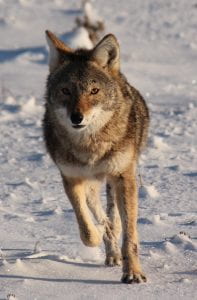by Drew Ricketts, extension wildlife specialist,
Spring calving season is upon us, and this brings the added concern of protecting calving cattle and their calves from predators. According to the National Agriculture Statistics Service, losses of calves to predators have increased steadily from 3.5% of all calf deaths in 1995 to 11.1% in 2015, based on a nation-wide survey of cattle producers. In Kansas, 0.2% of cattle losses and 4.6% of calf losses were due to predation. Coyotes are responsible for about two-thirds of the cattle losses and the vast majority (84%) of calf losses to predators. If we include the value of cattle and calves reported as injured but not killed with losses to predation, the total cost of predation to Kansas cattle producers is nearly $4 Million annually (based on 2015 market values).
So how can you protect your cattle and calves from coyote predation? The old adage, “an ounce of prevention is worth a pound of cure” applies to predator issues, just as it does to many other situations. Calving close to areas with high human activity and lights, such as a lot at the farmstead can discourage coyotes and other predators from mingling with the herd and encountering vulnerable calves. However, this is not practical for many producers. Other practices such as removing dead livestock from calving pastures and not calving close to carcass disposal sites are very important because coyotes will travel several miles outside of their normal territory to feed on large resources like a carcass. Livestock guardian animals are commonly used by sheep producers to protect their flocks from predators. Guardian animals are not used by many cattle producers in Kansas but could be a useful tool for producers who experience chronic calf losses to predators.

Lethal control is the most intuitive method that comes to mind for folks who are experiencing predation issues. However, the success of predator control efforts can be greatly hampered by the biology of the critter involved. Coyotes, for instance, have a mechanism to deal with population changes called compensatory natality. In other words, coyote populations can compensate for imbalances in the ratio of resources to coyote density through natural adjustments in birth rate (natality). When coyote populations are high or food is scarce, an average litter of coyotes would contain 3 pups and females typically will not breed until they are at least 2 years old. When coyote populations are low and/or food is abundant, an average litter will contain 8 pups and most female pups produced the previous spring will breed. This allows coyote populations to recover from intensive removal efforts within a year or so.
The social hierarchy of coyote populations, which includes resident and transient individuals, can also complicate population control efforts in the short term. Residents are breeding pairs with established territories, and one or two of their previous years’ offspring. Transients are coyotes that haven’t secured a territory and have very large home ranges that overlap the territories of several residents. Transients are waiting for the opportunity to claim a territory when a resident dies, and up to 50% of the individuals in an area can be transients. This ‘surplus’ of coyotes and their use of vocalizations and scent marking to maintain territories ensures that vacated territories are quickly filled. In fact, statistical models have indicated that more than 70% of the coyotes in an area would have to be killed every year for 50 years to eradicate them.
Even though population-level control of coyotes is not an effective method for most producers to deal with coyote predation, lethal control of the individuals that are causing damage is very effective. As my predecessor often said, “Death works!”, and offending coyotes can often be removed by concentrating trapping and calling efforts in the area where calves are lost, and coyote sign is found. There is no closed season on coyotes in Kansas. Anyone with a valid Kansas hunting license may hunt coyotes, and anyone with a valid Kansas furharvester license may trap or snare coyotes. Additionally, landowners or legal occupants of land may take coyotes “when found in or near buildings on their premises or when destroying property” including livestock and pets, as long as there is no attempt made to use the animal after it is killed. Any local restrictions related to the use of traps and snares, or discharging firearms must also be followed. There are no toxicants registered for the control of coyotes in Kansas.
Kansas livestock producers experiencing coyote damage have several options for receiving assistance with lethal control efforts. Local trappers and predator hunters are often happy for the opportunity to harvest coyotes on new properties, especially during the Kansas furbearer season from mid-November to mid-February. There are also many Nuisance Wildlife Damage Control operators throughout the state who will provide wildlife damage control assistance for a fee. A list of NADC permit holders, their location, and the species that they control may be found here. The Wildlife Damage Control Act of 1972 directs K-State Research and Extension to conduct a statewide program in wildlife damage control. Through this program, the Extension Wildlife Specialist is available to provide training to farmers and ranchers in effective control techniques and provide, on loan, control equipment not readily available. Contact information for the Extension Wildlife specialist can be found here.
For additional information on wildlife management, including how to trap coyotes and other wildlife damage control issues, please visit the KSRE Wildlife Management website and YouTube channel.